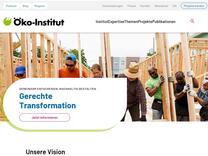Sustainable Resource Output | oeko.de https://www.oeko.de/publikation/sustainable-resource-output/
Article published in: „Sustainable Development and Resource Productivity – The Nexus Approaches“ Edited By Harry Lehmann, Copyright Year 2021, ISBN 9780367429546, Published November 18, 2020 by Routledge, 386 Pages 56 Color Illustrations.This book is included in the following series: Factor X: Studies in Sustainable Natural Resource Management The Open Access version of this book, available at https://www.taylorfrancis.com/books/e/9781003000365, has been made available under a Creative Commons Attribution 4.0 International License.
Publikationen Energiewende und Klimapolitik Energie & Klimaschutz Bücher

